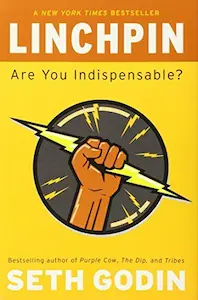Linchpin - Summary
Seth Godin

Introduction
In his groundbreaking book, “Linchpin: Are You Indispensable?”, Seth Godin challenges conventional wisdom about work and explores the concept of becoming a linchpin in today’s ever-changing world. Through a combination of thought-provoking insights, real-life examples, and captivating anecdotes, Godin presents a compelling argument for embracing our unique abilities and transforming ourselves into indispensable contributors in the workplace. This book summary will delve into the key ideas and principles presented in “Linchpin,” showcasing the importance of becoming a linchpin and providing practical strategies for achieving this status.
The Age of the Factory Worker is Over
Godin begins by highlighting the shift in the nature of work, emphasizing that the era of the factory worker, who merely follows instructions and completes repetitive tasks, is rapidly fading away. With the rise of automation and globalization, these jobs are becoming increasingly replaceable. To thrive in the modern economy, individuals must embrace their creativity, initiative, and ability to make a difference. Godin refers to these individuals as “linchpins.”
The Linchpin Mindset
According to Godin, a linchpin is someone who brings unique value to their work, going beyond the expected and becoming indispensable. Linchpins are not limited by job titles or specific roles; instead, they bring their whole selves to their work, constantly seeking to make a difference and leaving their mark. They are driven by passion, purpose, and a desire to contribute meaningfully.
Overcoming the Resistance
One of the key challenges to becoming a linchpin is overcoming the resistance that holds us back. Godin describes resistance as the internal force that seeks to keep us within our comfort zones, preventing us from taking risks and embracing our true potential. By understanding and acknowledging this resistance, individuals can work towards overcoming it and stepping into their linchpin role.
The Art of Shipping
Shipping refers to the act of delivering our work to the world, overcoming the fear of judgment and failure. Godin emphasizes the importance of consistently shipping our work, even if it’s not perfect. Linchpins understand that perfection is unattainable, and instead focus on creating and sharing their unique contributions. By consistently shipping, they build trust and credibility, ultimately becoming indispensable.
Embracing Emotional Labor
Emotional labor, as Godin defines it, is the effort we put into connecting with others, understanding their needs, and empathizing with their experiences. Linchpins excel at emotional labor, as they understand that building relationships and fostering connections are essential components of their work. By investing in emotional labor, linchpins create a sense of trust and loyalty, making them invaluable assets in any organization.
Becoming an Artist
Godin encourages readers to view their work as an art form, regardless of their field or industry. By embracing the mindset of an artist, individuals can infuse their work with passion, creativity, and originality. Artists are not limited by rules or boundaries; they constantly push the envelope and challenge the status quo. Linchpins approach their work as artists, constantly seeking to innovate and bring their unique perspective to the table.
The Power of Gifts
Gifts, as Godin explains, are acts of generosity and kindness that go beyond what is expected. Linchpins understand the power of gifts and use them strategically to build relationships, create opportunities, and make a lasting impact. These gifts can be as simple as offering assistance, sharing knowledge, or providing support. By giving generously, linchpins create a network of goodwill and reciprocity, further enhancing their indispensability.
The Importance of Education
Godin challenges the traditional notion of education, emphasizing that it is not limited to formal schooling or degrees. Linchpins are lifelong learners, constantly seeking knowledge, developing new skills, and adapting to change. They understand that education is a continuous process, and they actively invest in their personal and professional growth. By staying ahead of the curve, linchpins remain relevant and valuable in an ever-evolving world.
The Resistance to Linchpins
While becoming a linchpin is a transformative journey, Godin acknowledges that resistance exists within organizations. Some individuals and systems are threatened by linchpins, as they disrupt the status quo and challenge established norms. However, Godin argues that organizations must embrace and nurture their linchpins, as they are the catalysts for innovation, growth, and success. By creating an environment that encourages and rewards linchpin behavior, organizations can thrive in the modern economy.
Embracing the Linchpin Within
In the final section of the book, Godin encourages readers to embrace their inner linchpin and take the necessary steps to become indispensable. He provides practical advice on how to develop the skills, mindset, and habits of a linchpin. From cultivating emotional intelligence to embracing failure and taking risks, Godin offers a roadmap for personal transformation and professional success.
Conclusion
“Linchpin: Are You Indispensable?” challenges us to rethink our approach to work and embrace our unique abilities. Through captivating examples and thought-provoking insights, Seth Godin inspires readers to become linchpins – individuals who bring their whole selves to their work, make a difference, and become indispensable in an ever-changing world. By embracing the principles outlined in this book, individuals can unlock their true potential, thrive in their careers, and leave a lasting impact.